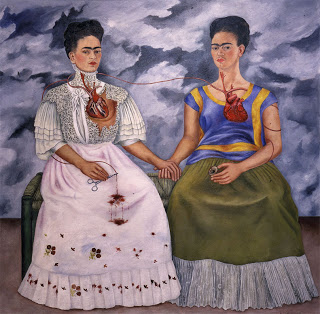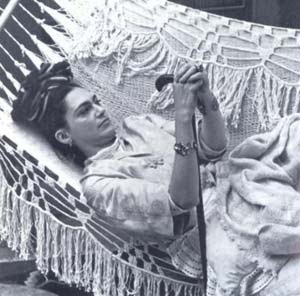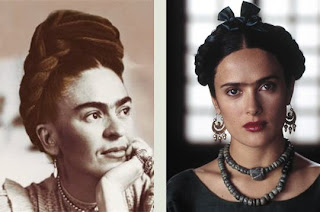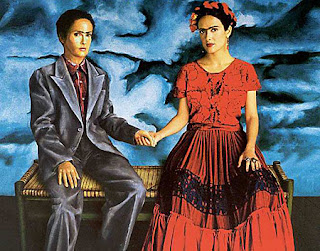This is the first in three posts about Frida Kahlo, an exhibit at the Philadelphia Museum of Art. To read about the merchandise at the exhibit gift show, go to post 2, here. To read about the show itself, go to post 3 here.

The bibliography on Frida Kahlo (1907-1954) is long, but of recent vintage. Worldcat lists over seven hundred books with Frida as subject; I scanned the first hundred and none pre-dates 1982. Those first hundred titles include the artist’s writings, three novels, multiple children’s books, biographies, the expected art historical monographs, a bibliography and one memoir/cookbook (Rivera Marin’s Frida’s Fiestas; recipes and reminiscences of life with Frida Kahlo, 1994). It also includes a book analyzing the phenomenon of Frida: Margaret Lindauer’s Devouring Frida; the art history and popular celebrity of Frida Kahlo (1999).
And then there are the films: two feature-length and at least four educational or made-for-television films. Film biopics of artists are rare; after all, showing someone painting is about as exciting as watching paint dry. Frida is all-time star material among women artists, and right up there with Rembrandt and Van Gogh as the subject of commercial films. The fact that so many of Frida’s paintings are self-portraits must have contributed to her interest to film-makers, as did her varied sex life and political involvement. I’ll look at the feature films not as a film critic, but as an art historian interested in an artist’s life.

Ofelia Medina as Frida in Frida, naturaleza viva (1984)
Several years ago I went to the local Blockbuster to rent the much-lauded Julie Taymor film on Frida and returned, to my surprise, with a Mexican Film, Frida, naturaleza viva (Frida; still life) made in 1984 by Paul Leduc. I was impressed then, and even more so on repeat viewing with the seriousness of the project. Not only do most of the actors bear remarkable resemblance to the figures we know through photographs (Ofelia Medina as Frida, Valentina Leduc Navarro as the young Frida, Max Kerlow as Leon Trotsky; while Juan José Gurrola is good as Diego Rivera, no actor could truly resemble Diego), but the bit parts and crowd scenes are peopled with authentic-looking types, bad teeth and all. In one scene of a New Year’s party given by the artists’ and writers’ section of the Communist party the dancers are believably middle-aged and paunchy, as would never be found in Hollywood.
The film emphasizes Frida’s feelings rather than actions, particularly in her relations with Diego, and portrays her passion for politics as equaling, if not exceeding her passion for art or for sex. She is shown distributing leaflets and at various events sponsored by the Communist Party, and her coffin is draped with the Party flag. Her life is depicted in relation to the major political events of the day, from Hitler’s marches to the detonating of the atom bomb. It gives an idea of Frida’s interest in Mexican popular culture, with wonderful scenes of peasants singing and several instances in which popular dance songs provide a commentary on Frida’s current situation.
Leduc’s film is filled with details that ring true, and add subtlety to the characterization: Frida’s environment includes just the sort of visual material that would have interested her: photos, prints, newspaper clippings, ex votos and Posada prints. Trotsky’s study is hung with early Soviet posters and Constructivist prints. During a dinner with Trotsky and his wife, Diego and Trotsky speak in French, Frida and Trotsky’s wife in German while Diego and Frida communicate in Spanish, rather the effect of a similar scene in Rules of the Game, and impossible in a film made in entirely in English. I did notice one musical anachronism, but the visual material all looked proper.
It’s a film about looking. Leduc does not employ a musical soundtrack throughout, but is willing to tolerate silence. He includes slow pans of Frida looking at her own work, shows us both her work and that of Diego and ends with a sequence of Frida’s self-portraits. Most poetic is Leduc’s use of mirrors as a leitmotif: the film opens with Frida on her deathbed, looking repeatedly into a mirror on the bed, as if she needs to see her own features to truly know what she feels. The mirrors inherent to self-portraiture re-appear throughout.

Frida Kahlo, left and Salma Hayek as Frida, right
Julie Taymor’s Frida (2002) is faster-paced (though longer), filled with parties and dancing and all the guests are good-looking. It begins with sex and violence: explicit scenes of Diego with his model and a young Frida with her first boyfriend, then the trolley accident that destroyed her health. Frida’s sexual exhibitionism runs throughout the movie. I’d rather have left all that to the imagination.
Salma Hayek was well-cast as the adult Frida, although make-up with a single eyebrow might convert almost any actress into a reasonable likeness (Hayek couldn’t quite bear to display Frida’s slight moustache, a feature attractive in some cultures, if not ours). But she’s a poor Frida the girl, and Alfred Molina’s only resemblance to Diego is his height; despite some padding he doesn’t come close to the ungainliness of the artist.

Salma Hayek as an invented painting of two Fridas from the film, Frida Kahlo (2002)
Taymor includes good views of the actual paintings and introduces many scenes with paintings which fade into tableaux with actors. Frida’s work gives the film much of its weight. After all, her life was the stuff of movies, as they say. But Taymor is never really content to suggest the patient activity and thought that the paintings required. Still, the movie includes plenty of local color, including good recreations of Casa Azul, Frida’s house. As a film it is well-made, entertaining and justly-popular. But I’d choose the Mexican biopic any time.
To read about the merchandise at the exhibit gift show, go to post 2, here. To read about the show itself, go to post 3 here.








